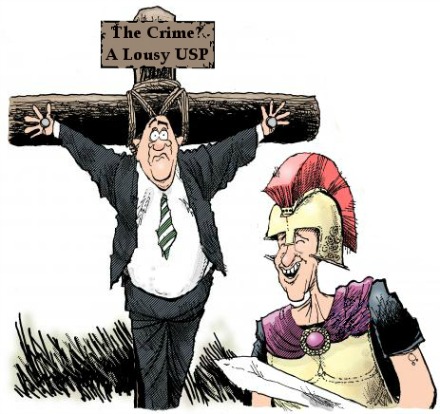As a business owner, you are the master and commander, the captain of your own ship. Your small business marketing plan is your map across the furies of a tempestuous sea. But like the Romans of old, the market has but little mercy for a defeated general.
In the days of Caesars and gladiators, and even earlier than that with the likes of the Spartans, the cry was for total victory. “Come back with your shield – or on it,” Plutarch tells us did Spartan mothers holler to their sons on their way to battle. Those who died in battle could expect their moms openly to rejoice on the news. Those instead who survived knew that they’d bring only shame and disgust back home with them. What’s your case?
Are we much farther from those days today?
Ask yourself the following. If you failed in your small business venture and then had to switch back to wage slave status, will your relatives openly rejoice about it?
If you have nothing to show for after years of building an online or storefront business and then had to report you’re back to punching the clock card, will former work colleagues respect you more?
Will you be able to convince another businessman to employ you to lead his business to victory if failure is all you’ve reached yourself trying to run your own?
But Is The Roman Way Also Your Way Of Stimulating A Business Victory?
“Now listen to me, all of you. You are all condemned men. We keep you alive to serve this ship. So row well, and live.”
So said Quintus Arrius, the Roman fleet commander in the movie Ben-Hur. He believed that service was best stimulated through hatred: “Hate keeps a man alive. It gives him strength,” he said.

But strength for what? What stimulates you to remain active in your daily battle when your business is not performing according to plan?
“Hatred of failure,” you might answer.
“Yeah. But why win then?”
Do you row well just to be alive and suffer pointlessly all along the way?
What if there was a better way? What if you could reach victory at sea without useless suffering?
What if to do so all you needed was to add ONE key ingredient to your small business marketing plan? Would you keep yourself then from spilling your own guts even if your ship went down in the fight?
You bet you would! You’d do so that you may live to fight another day! And this is what a USP gives you.
A USP gives you the highest potential of victory and a reason to try for victory again and again, were you to fail in your first attempts at success.
A Small Business Marketing Plan Without A USP Is Like Your Business Dying By Crucifixion
We’ve forgotten what death by crucifixion is like. It’s slow and painful, yes, it involves asphyxiation. But it is all this by design. When you fail to have a USP as the heart of your small business marketing plan, you are condemning your business to a slow, torturous death by your own design.
The crucifixion itself is unmatched throughout history for the severity of torment it brought.
The condemned man was affixed to the cross with nails driven through his wrists and feet. Through experimentation and the study of anatomy the Romans had discovered the medial nerve located just above the wrist joint and the center of the foot. The weight of the body caused the nail to press against this nerve shooting horrific pain throughout the nerves of the body.The weight of the body, pulling down on the outstretched arms and shoulders, would tend to fix the intercostal muscles in the position of inhalation. The only way the man could exhale was to lift with his arms and push with his legs to hold himself up for a few seconds to allow the air to escape from his lungs. To avoid suffocation the man was forced to cause his own excruciating pain by putting more pressure on the medial nerves.
The average life span of a person on the cross was three to four days. After four days the soldiers would help the person to die quickly by breaking his legs so that he could not use them to push himself upward to exhale. After a few hours, the muscles in the shoulders would lock and the man would die from exhaustion asphyxia or suffocation.
Why make such a big deal about this?
I want you to remember the point graphically. A USP is that important.
And So, At Long Last What Is A USP?
A USP is that which keeps a customer from ignoring you, from confusing you with your competitor. It keeps you from getting lost in the noisy crowd and sinking penniless into oblivion. A USP magnetizes you. It makes you irresistible to your ideal client. It more than identifies you as valuable. It makes you invaluable to a specific group of people in the market. It makes them obsessively seek for your exclusive treatment. It turns them into devoted clients who will sing your praises and stimulate further business for you.
Sounds almost magical, huh?
Well, it’s quite real.
The heart of all your small business marketing is your marketing value proposition, also known as your unique selling or unique service proposition, also known as your USP.
EVERYTHING in marketing for your business depends on it.
And your USP starts with your choice of target audience. It starts with its wants and how whatever you do for it will individually benefit its members enough to fulfill those wants in full.
If you get too far ahead of your USP, like by trying to do what I call “inbound marketing” (e.g. executing Search Engine Optimization campaigns or content generation work like creating a blog, YouTube videos, podcasts, Yellow Pages ads) or “outbound marketing” (e.g. emailing campaigning, telemarketing, advertising) or any PR and community outreach work, or anything else that marketers love to do in lieu of having to work first on crafting a reliable USP, then you’ve put the cart before the horse and you’re not going to grow. At best you’re going to plod through. Most likely you’ll just go broke. Guaranteed. If it can happen to PalmPilot from U.S. Robotics, it can more than happen to you.
It may seem dated but the story remains as true today as it was when it happened. So, learn from it.
Here’s a summary from the San Francisco Chronicle, as the #1 reason why the PalmPilot crashed, leading to Palm folding and Hewlet-Packard salvaging the pieces. This is a story that repeats itself far more often with small businesses than with large companies, which means it’s more likely to happen to you:
Palm never gave anyone a reason to buy the Pre instead of an iPhone, BlackBerry, or Android phone. This was a failure across Palm’s engineering, design, and marketing teams. And it’s not like Palm is the ONLY company to have this problem. But if Palm was going to have any chance to compete with RIM, Apple, and Android phones, it needed SOMETHING important that was better, that Palm’s marketing people could communicate was better to would-be buyers. It didn’t have that. Everything was too little, too late.
This is called a failure in having a unique selling proposition or USP. Marketing directs engineering on what engineers should deliver to the market. Marketing’s plan failed to establish the benefit-laden distinctiveness that Palm needed to compete against the colossal iPhone and the ubiquitous Android. Palm’s sixteen years of leading, visionary performance, of establishing the cell phone market and setting the tone for this industry slowly went down the drain! The culprit?
It wasn’t technology but Marketing.
Watch this if you don’t believe me.
After seeing this ad, are you going “Huh?”
Precisely! This is exactly what a USP is not! This is why Palm crashed and burned.
And it was all Marketing’s fault. Just read what Donald Melanson, Sr. Associate Editor with AOL Tech, had to say about it back then.
As far as we’ve come in the 16 years since the release of the original Pilot, it’s also remarkable how much hasn’t changed. The screens have gotten better, the hardware has gotten sleeker, and everything has gotten far more connected, but we’re still carrying around handheld devices that supplement our main computer, help us stay organized, and have a simplified operating system with apps displayed as a grid of icons. Add in some WiFi, 3G and a decent web browser and we could almost see ourselves getting by with one of these [PalmPilots] today — and that’s quite a testament to Palm’s original vision.
Yes, it was Palm’s last will and testament! In vision and technology that business had been far ahead from competitors. Soon enough, however, it lost its significant lead. They blew it with their marketing. They created no unique selling proposition and got crucified.
Fail in creating your USP and you will fail in your small business too. You will get crucified by your competitors. It’s that simple. And it will be painful, because you will struggle against all odds to survive. Palm did so for sixteen years, and yet, in the end you will die anyway.
This is why I created this brief series of videos to explain the pivotal characteristics of a USP statement and how to draft one. Last week alone I analyzed no less than 25 online businesses, whose owners sought in my reviews for insight about their marketing value propositions.
In the words of one of them, “You’re making me and I’m sure a lot of other people as well, look at our web sites with completely new eyes. Looking outside the box, so to say.”
Are you still interested in creating your small business marketing plan without first having a Unique Selling or a Unique Service Proposition (USP) to anchor that plan to?
If not, then watch the videos below for my insights on how to create your company’s USP and keep your ship in fighting order, commander.

